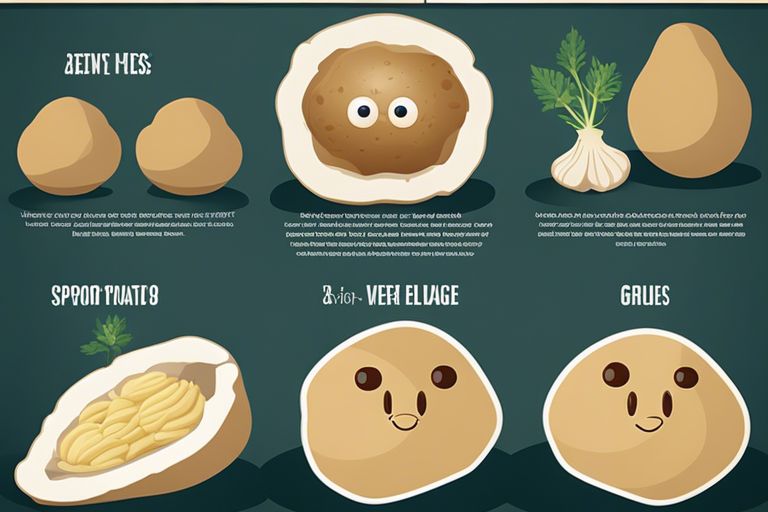Perceiving the signs of spoilage in a potato is crucial to avoiding potential health risks and ensuring the quality of your meals. No one enjoys discovering a rotten potato hiding in the back of the pantry or buried under a pile of fresh produce. In my blog post, I will guide you through the Signs That a Potato Is Bad: Raw & Cooked, including the dangerous toxins that can occur and the positive signs of a fresh, quality potato. Whether you’re a seasoned cook or a novice in the kitchen, knowing when to toss out that spud is essential for maintaining a safe and enjoyable cooking experience.
Key Takeaways:
- Check for mold: Moldy spots on the potato are a clear sign that it has gone bad and should not be consumed.
- Look for sprouts: If the potato has started to sprout, it may be past its prime and should be used soon to avoid waste.
- Inspect for soft spots: Soft or spongy areas on the potato indicate decay and should be removed before consuming the rest of the potato.
- Smell for foul odors: A foul or unpleasant smell coming from the potato is a strong indication that it has spoiled and should be discarded.
- Pay attention to discoloration: Dark spots, browning, or discoloration of the skin can be a sign of spoilage and the potato should be discarded.
Visual Signs of a Bad Potato
Some of the most common visual signs that a potato has gone bad can be detected with a quick visual inspection. These signs can include mold growth, discoloration, and other visible changes to the potato’s surface. Paying attention to these visual cues can help you determine whether your potato is safe to eat or if it’s time to toss it out.
Mold Growth
If you notice any fuzzy green, white, or black spots on the surface of the potato, it’s a strong indicator that it has developed mold. Moldy potatoes should be discarded immediately, as consuming them can lead to food poisoning. Mold can produce harmful toxins, so it’s crucial to avoid any contact with it. Always handle moldy potatoes with caution and dispose of them properly to prevent contamination of other food items.
Discoloration
Another visual sign of a bad potato is discoloration. Look for any dark spots, browning, or soft areas on the skin of the potato. These changes in color and texture can indicate that the potato is starting to spoil. Furthermore, any green tint on the skin of the potato is a result of a natural chemical reaction that occurs when potatoes are exposed to light. This green coloration in potatoes contains a toxic compound called solanine, which can cause digestive issues and other health problems if consumed in large quantities. If you notice any discoloration on your potato, it’s best to err on the side of caution and discard it to avoid potential health risks.
By being aware of these visual signs of a bad potato, you can prevent consuming potentially harmful food and prioritize your health and well-being. Remember, when in doubt, it’s better to throw it out. If you want to learn more about identifying bad potatoes, check out How To Tell If a Potato Is Bad — 6 Ways to Know for additional tips and insights.
Scent and Texture
If you suspect that a potato may be bad, the first thing to do is to rely on your senses. The smell and texture of a potato can provide valuable clues about its freshness.
Foul Odor
When checking for a bad potato, be sure to give it a good sniff. A fresh potato should have a neutral, earthy scent. If you detect a foul or musty odor, it is a strong indication that the potato has spoiled. The pungent smell is a result of the build-up of bacteria, and consuming such potatoes can lead to food poisoning. If you encounter this odor, it is best to discard the potato immediately.
Soft or Spongy Texture
Another sign of a bad potato is a soft or spongy texture. When you gently press on a fresh potato, it should feel firm and solid. If you notice any soft spots or a spongy feel, it is a clear indication that the potato has begun to spoil. These areas are often the result of rot and mold growth, and consuming such potatoes can be harmful to your health. Discard any potatoes with these textural abnormalities to avoid consuming harmful bacteria.


How to Tell if a Potato Is Bad – What Are the Signs?
Hence, it is important to pay attention to the signs that indicate a potato has gone bad. By inspecting the appearance, smell, and texture of the potato, you can easily determine if it is no longer safe to eat. Remember, a healthy potato should have a smooth skin, firm texture, and earthy smell. If you notice any signs of decay, such as wrinkled skin, soft spots, or mold, it is best to discard the potato to avoid any potential health risks. By being vigilant and following these simple guidelines, you can ensure that the potatoes you consume are safe and delicious.
FAQ
Q: How do I tell if a potato is bad?
A: To determine if a potato is bad, look for signs of spoilage such as discoloration, sprouting, softness, and unpleasant odor.
Q: What does a bad potato look like?
A: A bad potato may have greenish or black spots, mold, or a wrinkled and shriveled appearance. These are all indications that the potato is no longer safe to consume.
Q: Can you eat sprouted potatoes?
A: Small sprouts on potatoes can be removed and the potato can still be consumed if the flesh is firm and not discolored. However, if the sprouts are large or the potato feels soft, it is best to discard it.
Q: How should potatoes be stored to prevent spoilage?
A: Potatoes should be stored in a cool, dark, and well-ventilated place, away from moisture and sunlight. Additionally, it’s best to keep them separate from other produce to prevent the spread of spoilage.
Q: Are green potatoes safe to eat?
A: Green potatoes contain solanine, a toxic compound that can cause symptoms such as nausea, vomiting, and headaches. It is best to avoid consuming green potatoes to prevent potential health risks.









Leave a comment